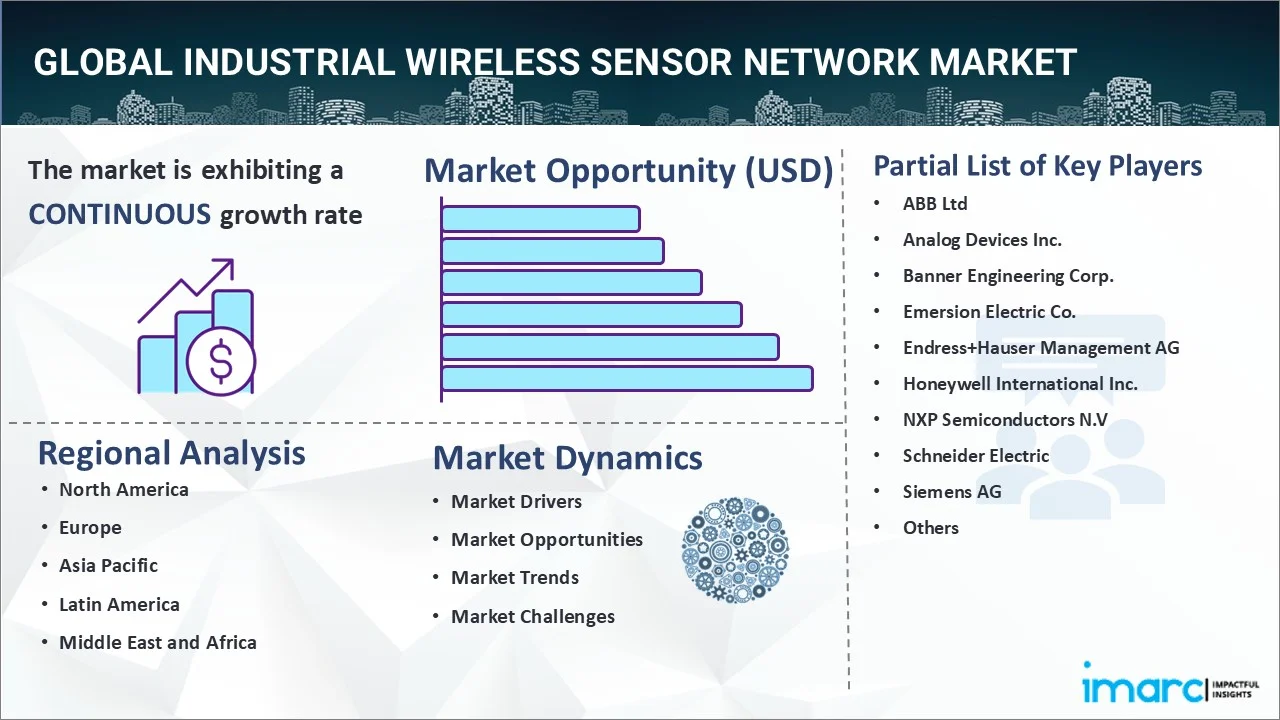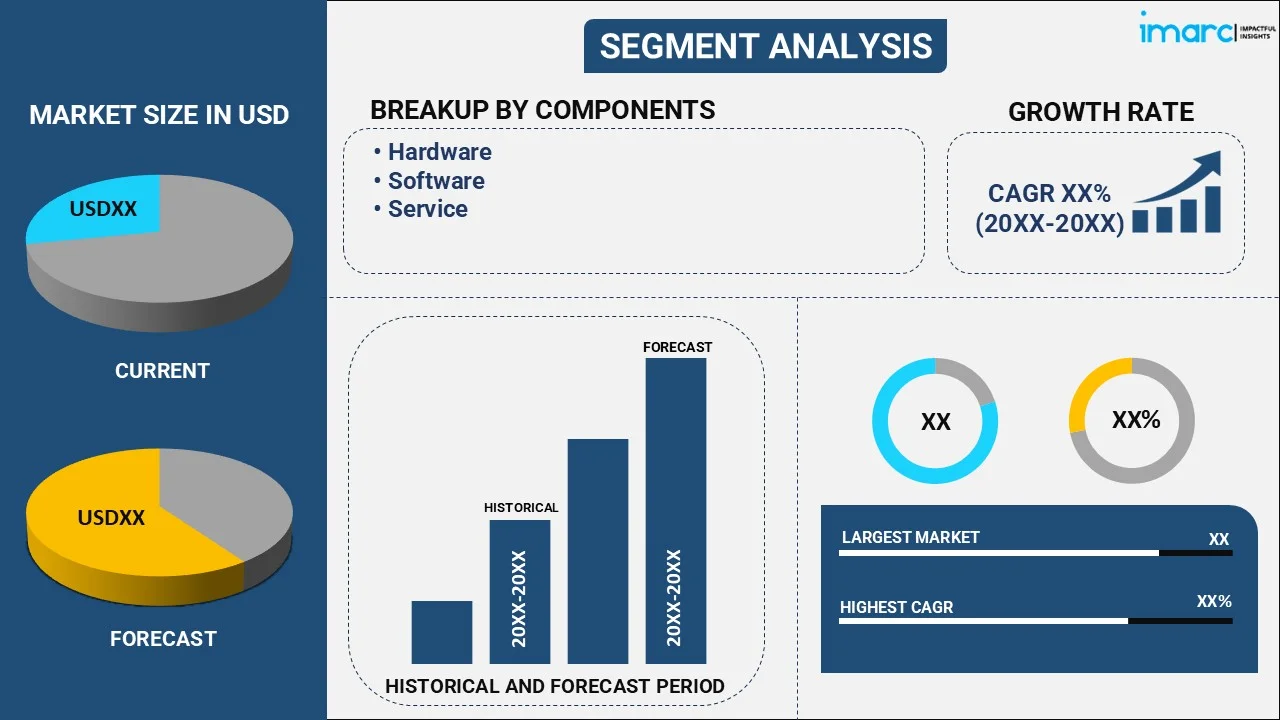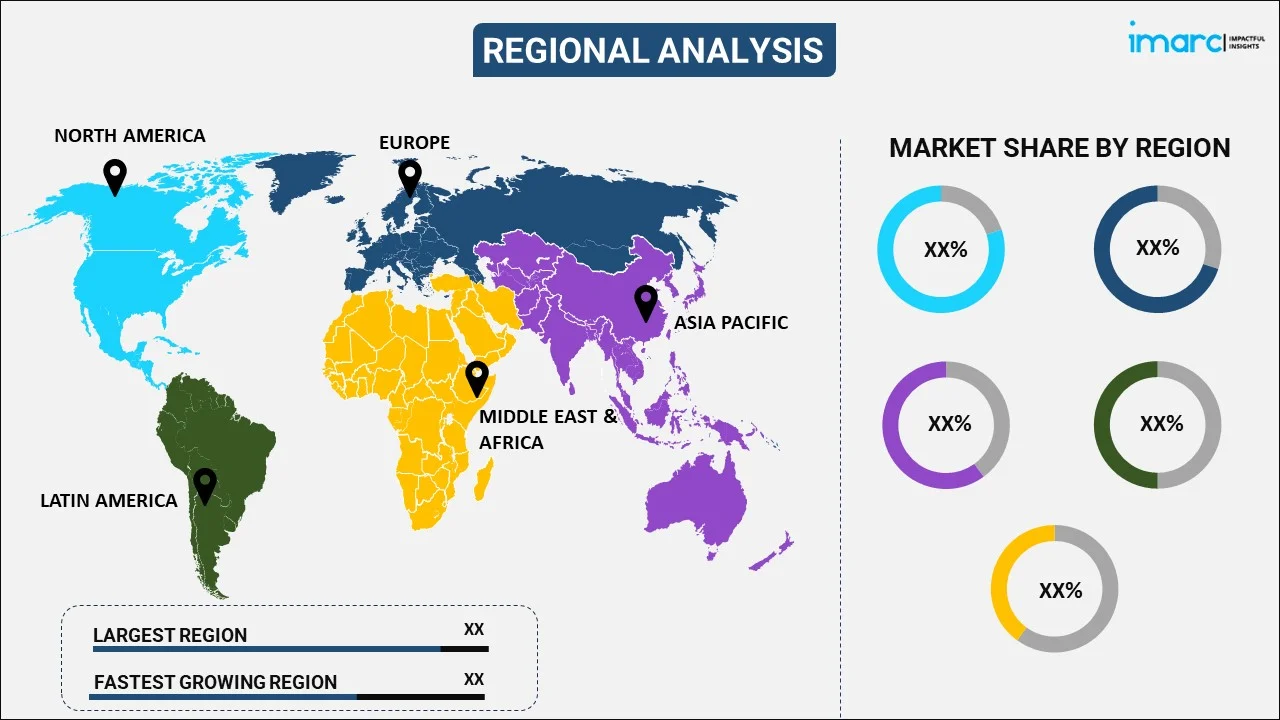
Industrial Wireless Sensor Network Market Report by Component (Hardware, Software, Service), Sensor Type (Pressure Sensor, Temperature Sensor, Level Sensor, Flow Sensor, Biosensor, and Others), Application (Machine Monitoring, Process Monitoring, Asset Tracking, Safety and Surveillance), End Use (Automotive, Food and Beverages, Manufacturing, Mining, Oil and Gas, Utilities, and Others), and Region 2025-2033
Global Industrial Wireless Sensor Network Market:
The global industrial wireless sensor network market size reached USD 8.0 Billion in 2024. Looking forward, IMARC Group expects the market to reach USD 29.5 Billion by 2033, exhibiting a growth rate (CAGR) of 14.82% during 2025-2033. The growing industrial automation and digitalization, IoT integration, real-time data monitoring, ongoing technological advancements, and the rising adoption of smart cities are primarily driving the market's growth.
|
Report Attribute
|
Key Statistics
|
|---|---|
|
Base Year
|
2024
|
|
Forecast Years
|
2025-2033
|
|
Historical Years
|
2019-2024
|
|
Market Size in 2024
|
USD 8.0 Billion |
|
Market Forecast in 2033
|
USD 29.5 Billion |
| Market Growth Rate (2025-2033) | 14.82% |
Industrial Wireless Sensor Network Market Analysis:
- Major Market Drivers: The growing demand for IWSN to improve communication between industrial devices and ensure seamless communication using wireless systems represents one of the key factors driving the market. Besides this, there is a rise in the utilization of artificial intelligence (AI), machine learning (ML), and big data analytics to analyze the large database of temperature, motion, pressure, gas, flow, and chemicals, which is further contributing to the growth of the market.
- Key Market Trends: The growing demand for the Internet of Things (IoT) connected devices around the world, such as smart mobiles, refrigerators, fire alarms, door locks, bicycles, and fitness trackers, is positively influencing the market. Apart from this, the increasing application of IWSN in robotics for sensing, recognition, and interpretation of numerous programs is propelling the growth of the market.
- Competitive Landscape: Some of the prominent industrial wireless sensor network market companies include ABB Ltd, Analog Devices Inc., Banner Engineering Corp., Emersion Electric Co., Endress+Hauser Management AG, Honeywell International Inc., NXP Semiconductors N.V, Schneider Electric, Siemens AG, ST Microelectronics, Texas Instruments Inc., and Yokogawa Electric Corporation, among many others.
- Geographical Trends: According to the industrial wireless sensor network market dynamics, North America exhibits a clear dominance in the market. Companies are increasingly focused on obtaining real-time data to make informed decisions, improve operational efficiency, and reduce downtime, which drives the demand for advanced sensor networks.
- Challenges and Opportunities: The rising security concerns and high initial costs with the deployment of these technologies are hampering the market's growth. However, emerging technologies, such as 5G, advanced IoT protocols, and energy-efficient sensors, present numerous opportunities for enhancing the capabilities and performance of wireless sensor networks.

Industrial Wireless Sensor Network Market Trends:
Rising Adoption of Autonomous Vehicles
The increasing adoption of autonomous vehicles is contributing to the growth of the Industrial Wireless Sensor Network (IWSN) market. For instance, according to IMARC, the global autonomous vehicle market size reached US$ 81.0 Billion in 2023. Looking forward, IMARC Group expects the market to reach US$ 1,171.6 Billion by 2032, exhibiting a growth rate (CAGR) of 33.5% during 2024-2032. Autonomous vehicles rely heavily on a wide range of sensors (LIDAR, radar, cameras, etc.) to perceive their environment, make decisions, and navigate safely. This reliance drives the demand for advanced sensor networks that can provide real-time, accurate data. The technology and infrastructure needed to support these sensors align with the capabilities of industrial wireless sensor networks. These factors are expected to propel the industrial wireless sensor network market in the coming years.
Expansion of 5G Networks
The adoption of 5G networks is one of the significant drivers of growth in the Industrial Wireless Sensor Network (IWSN) market. For instance, according to Statista, in 2022, around one-tenth of all global connections used 5G technology, with this figure expected to exceed one-half by the end of the decade. North America, the developed countries in Asia Pacific, and the Gulf Cooperation Council (GCC) regions are anticipated to exceed 90% adoption by 2030. The rollout of 5G technology provides faster data transmission speeds, lower latency, and increased connectivity, which enhances the performance and reliability of wireless sensor networks. These factors further positively influence the industrial wireless sensor network market forecast.
Growing Demand for Industrial Internet of Things (IIoT)
The increased adoption of the Industrial Internet of Things (IIoT) is a major driver of growth in the Industrial Wireless Sensor Network (IWSN) market. For instance, according to Statista, in 2017, the automotive industry had a 13% adoption rate for industrial IoT. IIoT relies on a network of sensors to collect real-time data from various industrial processes and equipment. This data is critical for monitoring performance, detecting anomalies, and making timely decisions.
Global Industrial Wireless Sensor Network Industry Segmentation:
IMARC Group provides an analysis of the key trends in each segment of the global industrial wireless sensor network market report, along with forecasts at the global, regional, and country levels from 2025-2033. Our report has categorized the market based on component, sensor type, application, and end use.
Breakup by Component:

- Hardware
- Software
- Service
Software holds the majority of the total market share
The report has provided a detailed breakup and analysis of the industrial wireless sensor network market based on the component. This includes hardware, software, and service. According to the report, software holds the majority of the total market share.
According to the industrial wireless sensor network market outlook, software solutions are essential for integrating data from various sensors, performing complex analytics, and providing actionable insights. Advanced analytics and data visualization tools enable industries to make informed decisions based on real-time and historical data. Moreover, software platforms facilitate real-time monitoring and visualization of sensor data, allowing for immediate responses to changes and anomalies in industrial processes. Apart from this, software solutions can be scaled to accommodate growing sensor networks and expanding industrial applications. This scalability is crucial as industries deploy more sensors and require more sophisticated data-handling capabilities.
Breakup by Sensor Type:
- Pressure Sensor
- Temperature Sensor
- Level Sensor
- Flow Sensor
- Biosensor
- Others
Flow sensor currently exhibits a clear dominance in the market
The report has provided a detailed breakup and analysis of the industrial wireless sensor network market based on the sensor type. This includes pressure sensor, temperature sensor, level sensor, flow sensor, biosensor, and others. According to the report, flow sensor currently exhibits a clear dominance in the market.
According to the industrial wireless sensor network market overview, the shift towards Industry 4.0 and the Internet of Things (IoT) is driving the demand for wireless sensors, including flow sensors. These technologies enable more efficient monitoring and control of industrial processes. Moreover, industries such as oil and gas, chemical processing, and water management require real-time flow data to optimize operations and ensure safety. Wireless flow sensors provide the flexibility and efficiency needed for these applications. Besides this, improvements in sensor technology, such as enhanced accuracy, durability, and reduced power consumption, are making wireless flow sensors more attractive for industrial applications.
Breakup by Application:
- Machine Monitoring
- Process Monitoring
- Asset Tracking
- Safety and Surveillance
Process monitoring accounts for the largest market share
A detailed breakup and analysis of the industrial wireless sensor network market based on the application has also been provided in the report. This includes machine monitoring, process monitoring, asset tracking, and safety and surveillance. According to the report, process monitoring accounts for the largest market share.
The need to maximize production efficiency and minimize downtime drives the adoption of process monitoring solutions. Real-time data helps in optimizing machinery performance and reducing waste. Moreover, maintaining high product quality standards requires continuous monitoring of production parameters. Accurate sensors ensure that deviations are detected early, preventing defects.
Breakup by End Use:
- Automotive
- Food and Beverages
- Manufacturing
- Mining
- Oil and Gas
- Utilities
- Others
A detailed breakup and analysis of the industrial wireless sensor network market based on the end use has also been provided in the report. This includes automotive, food and beverages, manufacturing, mining, oil and gas, utilities, and others.
Automotive manufacturers seek to streamline production processes and reduce downtime. Wireless sensors facilitate real-time monitoring and control of assembly lines and equipment. Moreover, strict food safety and quality regulations drive the need for continuous monitoring of critical parameters, such as temperature, humidity, and contamination levels. Besides this, the need to enhance production efficiency and reduce operational costs drives the adoption of wireless sensors in the manufacturing sector. Real-time monitoring helps optimize machinery performance and reduce downtime. Apart from this, mining operations face stringent safety and environmental regulations. Continuous monitoring helps manage risks, detect hazardous conditions, and ensure regulatory compliance.
Breakup by Region:

- North America
- United States
- Canada
- Asia-Pacific
- China
- Japan
- India
- South Korea
- Australia
- Indonesia
- Others
- Europe
- Germany
- France
- United Kingdom
- Italy
- Spain
- Russia
- Others
- Latin America
- Brazil
- Mexico
- Others
- Middle East and Africa
North America currently dominates the global market
The report has also provided a comprehensive analysis of all the major regional markets, which include North America (the United States and Canada); Europe (Germany, France, the United Kingdom, Italy, Spain, Russia and others); Asia Pacific (China, Japan, India, South Korea, Australia, Indonesia, and others); Latin America (Brazil, Mexico, and others); and the Middle East and Africa. According to the report, North America currently dominates the global market.
According to the industrial wireless sensor network market statistics, North America is at the forefront of adopting Internet of Things (IoT) technologies and Industry 4.0 concepts. For instance, according to Statista, by 2030, North America is expected to have 8 billion IoT connections. The integration of wireless sensors with IoT platforms and advanced analytics drives the demand for sophisticated WSN solutions. Moreover, innovations in sensor technology, such as improved accuracy, lower power consumption, and enhanced connectivity, contribute to the growth of the WSN market. Besides this, companies in North America are increasingly investing in technologies that improve manufacturing efficiency and reduce downtime. Wireless sensors enable real-time monitoring of equipment and processes, leading to better operational efficiency and cost savings.
Competitive Landscape:
The market research report has provided a comprehensive analysis of the competitive landscape. Detailed profiles of all major market companies have also been provided. Some of the key players in the market include:
- ABB Ltd
- Analog Devices Inc.
- Banner Engineering Corp.
- Emersion Electric Co.
- Endress+Hauser Management AG
- Honeywell International Inc.
- NXP Semiconductors N.V
- Schneider Electric
- Siemens AG
- ST Microelectronics
- Texas Instruments Inc.
- Yokogawa Electric Corporation
(Please note that this is only a partial list of the key players, and the complete list is provided in the report.)
Industrial Wireless Sensor Network Market Recent Developments:
- January 2024: Nozomi Networks Inc., the industry provider in OT and IoT security, unveiled Guardian Air, the industry's only wireless spectrum sensor designed specifically for OT and IoT environments worldwide.
- November 2023: STMicroelectronics introduced a new microcontroller (MCU) that combines the company's wireless device design expertise with its high-performance and efficient STM32 architecture. The MCU is particularly useful in remotely deployed applications, such as metering and monitoring devices, as well as data from alarm systems, actuators, and sensors in today's smart buildings, factories, and cities.
- October 2023: NXP Semiconductors launched AW693, a new automotive-qualified wireless communication solution. AW693 was designed from the ground up for automotive use and is part of the industry's key comprehensive automotive wireless connectivity portfolio.
Industrial Wireless Sensor Network Market Report Scope:
| Report Features | Details |
|---|---|
| Base Year of the Analysis | 2024 |
| Historical Period | 2019-2024 |
| Forecast Period | 2025-2033 |
| Units | Billion USD |
| Scope of the Report | Exploration of Historical Trends and Market Outlook, Industry Catalysts and Challenges, Segment-Wise Historical and Predictive Market Assessment:
|
| Components Covered | Hardware, Software, Service |
| Sensor Types Covered | Pressure Sensor, Temperature Sensor, Level Sensor, Flow Sensor, Biosensor, Others |
| Applications Covered | Machine Monitoring, Process Monitoring, Asset Tracking, Safety and Surveillance |
| End Uses Covered | Automotive, Food and Beverages, Manufacturing, Mining, Oil and Gas, Utilities, Others |
| Regions Covered | Asia Pacific, Europe, North America, Latin America, Middle East and Africa |
| Countries Covered | United States, Canada, Germany, France, United Kingdom, Italy, Spain, Russia, China, Japan, India, South Korea, Australia, Indonesia, Brazil, Mexico |
| Companies Covered | ABB Ltd, Analog Devices Inc., Banner Engineering Corp., Emersion Electric Co., Endress+Hauser Management AG, Honeywell International Inc., NXP Semiconductors N.V, Schneider Electric, Siemens AG, ST Microelectronics, Texas Instruments Inc., Yokogawa Electric Corporation, etc. |
| Customization Scope | 10% Free Customization |
| Post-Sale Analyst Support | 10-12 Weeks |
| Delivery Format | PDF and Excel through Email (We can also provide the editable version of the report in PPT/Word format on special request) |
Key Benefits for Stakeholders:
- IMARC's report offers a comprehensive quantitative analysis of various market segments, historical and current market trends, market forecasts, and dynamics of the industrial wireless sensor network market from 2019-2033.
- The research study provides the latest information on the market drivers, challenges, and opportunities in the global industrial wireless sensor network market.
- The study maps the leading, as well as the fastest-growing, regional markets. It further enables stakeholders to identify the key country-level markets within each region.
- Porter's five forces analysis assists stakeholders in assessing the impact of new entrants, competitive rivalry, supplier power, buyer power, and the threat of substitution. It helps stakeholders to analyze the level of competition within the industrial wireless sensor network industry and its attractiveness.
- The competitive landscape allows stakeholders to understand their competitive environment and provides insight into the current positions of key players in the market.
Key Questions Answered in This Report
The global industrial wireless sensor network market was valued at USD 8.0 Billion in 2024.
We expect the global industrial wireless sensor network market to exhibit a CAGR of 14.82% during 2025-2033.
The rising demand for industrial wireless sensor network in machine health analysis, condition-based maintenance, automated metering, remote monitoring, etc., as it can automatically supervise processes without any manual intervention, is primarily driving the global industrial wireless sensor network market.
The sudden outbreak of the COVID-19 pandemic had led to the implementation of stringent lockdown regulations across several nations, resulting in the temporary halt in numerous installation activities for industrial wireless sensor network.
Based on the component, the global industrial wireless sensor network market can be segmented into hardware, software, and service. Currently, software holds the majority of the total market share.
Based on the sensor type, the global industrial wireless sensor network market has been divided into pressure sensor, temperature sensor, level sensor, flow sensor, biosensor, and others. Among these, flow sensor currently exhibits a clear dominance in the market.
Based on the application, the global industrial wireless sensor network market can be categorized into machine monitoring, process monitoring, asset tracking, and safety and surveillance. Currently, process monitoring accounts for the largest market share.
On a regional level, the market has been classified into North America, Asia-Pacific, Europe, Latin America, and Middle East and Africa, where North America currently dominates the global market.
Some of the major players in the global industrial wireless sensor network market include ABB Ltd, Analog Devices Inc., Banner Engineering Corp., Emersion Electric Co., Endress+Hauser Management AG, Honeywell International Inc., NXP Semiconductors N.V, Schneider Electric, Siemens AG, ST Microelectronics, Texas Instruments Inc., and Yokogawa Electric Corporation.
Need more help?
- Speak to our experienced analysts for insights on the current market scenarios.
- Include additional segments and countries to customize the report as per your requirement.
- Gain an unparalleled competitive advantage in your domain by understanding how to utilize the report and positively impacting your operations and revenue.
- For further assistance, please connect with our analysts.
 Inquire Before Buying
Inquire Before Buying
 Speak to an Analyst
Speak to an Analyst
 Request Brochure
Request Brochure
 Request Customization
Request Customization




.webp)




.webp)












